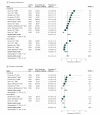Prevalence of Bacteremia and Bacterial Meningitis in Febrile Neonates and Infants in the Second Month of Life: A Systematic Review and Meta-analysis
- PMID: 30901044
- PMCID: PMC6583289
- DOI: 10.1001/jamanetworkopen.2019.0874
Prevalence of Bacteremia and Bacterial Meningitis in Febrile Neonates and Infants in the Second Month of Life: A Systematic Review and Meta-analysis
Abstract
Importance: Febrile neonates (persons in the first month of life) are believed to be at higher risk for bacteremia or bacterial meningitis than infants in their second month of life. However, the true prevalence is unclear.
Objective: To determine modern rates of bacteremia and bacterial meningitis in febrile neonates and infants in the second month of life presenting to an ambulatory setting.
Data sources: A comprehensive, no-limit search was conducted in PubMed using previously published search terms in February 2015 and repeated in September 2016.
Study selection: Abstracts and full texts were reviewed independently by several investigators. Studies were included if data regarding blood cultures or cerebrospinal fluid cultures from consecutive febrile infants in an ambulatory setting could be extrapolated within the age groups. To limit the analysis to the period after the availability of the Haemophilus influenzae type b vaccination, studies that collected data before 1990 were excluded.
Data extraction and synthesis: Data were extracted in accordance with the Meta-analyses of Observational Studies in Epidemiology (MOOSE) reporting guidelines via independent abstraction by several investigators. The Newcastle-Ottawa Scale was used to assess bias.
Main outcomes and measures: The primary outcomes were prevalence rates of bacteremia and bacterial meningitis in febrile neonates and infants in the second month of life. In neonates, prevalence rates were also estimated in the era of group B Streptococcus intrapartum antibiotic prophylaxis (after 1996).
Results: In total, 7264 abstracts were screened, resulting in 188 full-text manuscripts reviewed, with 12 meeting inclusion criteria (with 15 713 culture results). For febrile neonates, the prevalence of bacteremia was 2.9% (95% CI, 2.3%-3.7%; I2 = 50%; n = 5145) and the prevalence of bacterial meningitis was 1.2% (95% CI, 0.8%-1.9%; I2 = 27%; n = 3288). In neonates in the era after group B Streptococcus prophylaxis, the prevalence of bacteremia was 3.0% (95% CI, 2.3%-3.9%; I2 = 6%; n = 2055) and the prevalence of meningitis was 1.0% (95% CI, 0.4%-2.1%; I2 = 28%; n = 1739). For febrile infants in the second month of life, the prevalence of bacteremia was 1.6% (95% CI, 0.9%-2.7%; I2 = 78%; n = 4778) and the prevalence of meningitis was 0.4% (95% CI, 0.2%-1.0%; I2 = 33%; n = 2502).
Conclusions and relevance: These findings suggest that febrile neonates have approximately twice the rate of bacteremia and meningitis as febrile infants in their second month of life.
Conflict of interest statement
Figures





